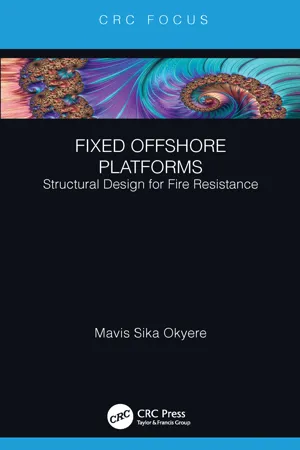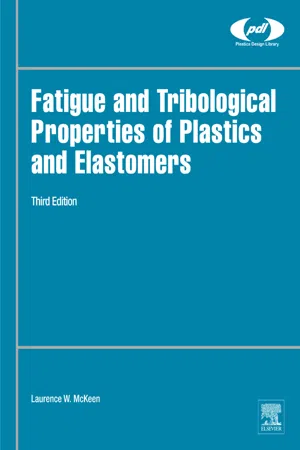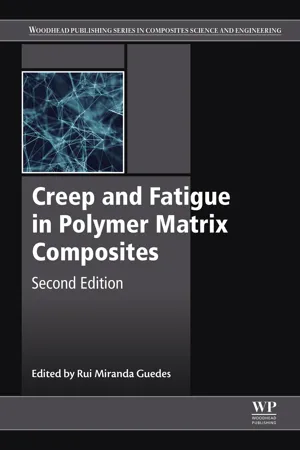Fatigue Material
Fatigue material refers to the degradation of a material's properties under cyclic loading, leading to eventual failure. This phenomenon is a common concern in engineering, particularly in the design and maintenance of structures and components subjected to repeated stress. Understanding fatigue material behavior is crucial for ensuring the reliability and safety of various mechanical systems.
5 Key excerpts on "Fatigue Material"
- Mavis Sika Okyere(Author)
- 2018(Publication Date)
- CRC Press(Publisher)
...8 Fatigue Analysis Fatigue is the weakening of a material caused by the repeated application and removal of stress. For example, if you bend a piece of metal back and forth repeatedly in the same spot, fatigue will result at the bend location and will weaken the metal until it eventually breaks. Technically, platforms experience fatigue as a result of periodic increases (application of stress) and decreases (removal of stress) in operating pressures. Because fatigue can cause a failure to occur at stress levels well below those that a material can withstand in a single, nonrepetitive loading, materials that must resist repeated stress cycles must be specially designed for this service. Durability is the ability of the material to resist fatigue. Fatigue analysis is done to ascertain the offshore platform structural response to continual wave loading. Fatigue analysis is carried out using the deterministic method or spectral method. Use the S – N curves to determine fatigue cycles. Also calculate the fatigue stress or fatigue damage. A detailed fatigue analysis should be performed for all structures as recommended in Section 5.2 of API RP 2A. The fatigue analysis is performed with input from a wave scatter diagram and from the natural dynamic response of the platform and the stiffness of the pile caps at the mud line by applying the Palmgren-Miner formula. Miner’s rule is probably the simplest cumulative damage model. It states that if there are k different stress levels and the average number of cycles to failure at the i th stress, S i, is N i, then the damage fraction, C, is C = ∑ i = 1 k n i N i (8.1) where n i = the number of cycles accumulated at stress S i C = is the fraction of life consumed by exposure to the cycles at the different stress levels...
- eBook - ePub
Fatigue of Materials and Structures
Application to Damage and Design
- Claude Bathias, André Pineau, Claude Bathias, André Pineau(Authors)
- 2013(Publication Date)
- Wiley-ISTE(Publisher)
...Chapter 3 Fatigue of Composite Materials 1 3.1. Introduction The term “composite materials” covers a large range of materials. Obviously, it is not always easy to find a general approach to determine the fatigue behavior of some materials, including polymer matrix, metal matrix and ceramic matrix composites, along with elastomeric composites, Glare, short fiber-reinforced polymers and nanocomposites. For this reason, we have to set up some boundaries. In addition, it is quite useful for the engineer to carefully compare the fatigue of composite materials to the fatigue of metals, as the design of a component made of a composite material is often the result of a metal substitution. We should keep in mind what Professor Tsaï said: “Think composite”. As Bryan Harris mentioned in Fatigue in Composites [HAR 03]: “it is wrong to assume, a priori, that there are some universal mechanisms by which fluctuating loads will inevitably result in failure at stresses below the normal monotonic failure stress of the material”. Fracture within high-performance composite material structures is of a very different nature compared to that of metallic components. Failure due to fatigue is less feared in the first case than in the second. Metallic fatigue has been intensively studied for more than 150 years, since the pioneering work performed by Wöhler. Nowadays, metallic fatigue is studied using some well-established concepts: – low-cycle fatigue by Coffin and Manson; – megacycle fatigue by Wöhler; – gigacycle fatigue by Bathias; – crack propagation by Paris. The fatigue of composite materials is slightly different, as gigacycle fatigue of composite materials has not yet been studied in detail, as the S-N curves are usually plotted between 10 3 and 10 7 cycles and no further [BAT 04]. We should also bear in mind that the concept of damage tolerance can only be applied to metals and not to composite materials...
- Laurence W. McKeen(Author)
- 2016(Publication Date)
- William Andrew(Publisher)
...To dependably design against fatigue failure, one needs a thorough engineering education and years of experience in engineering and materials science. There are three principal approaches to life assurance for mechanical parts: 1. Design to keep stress below threshold of the material’s fatigue limit (sometimes called the infinite lifetime concept). This depends on having enough fatigue data which this book aims to provide. 2. Design for a fixed life and plan to replace the part with a new one much like car manufacturers do with their maintenance schedules. This is sometimes called “a so-called lifed part,” finite lifetime concept [22], or “safe-life” design practice. 3. Plan to inspect the part periodically for cracks and replace the part once an observed crack exceeds a critical length. This approach usually requires an accurate prediction of the rate of fatigue crack growth. This sometimes is referred to as damage-tolerant design [23] or “retirement-for-cause.” There are other strategies to deal with the factors that accelerate fatigue listed in Section 1.5. Perhaps most important, apart from the material of manufacture, is paying particular attention to the manufacturing process. The aim is to minimize internal and surface defects that concentrate stresses. One can also engineer temperature control and environmental exposure. 1.7. Summary This chapter has provided a general summary of fatigue concepts, measurement techniques or methods, data presentation, and theory. It was meant to be introductory only and additional details should be obtained from the literature cited in this chapter [ 24 – 26 ]...
- Anthony Sofronas(Author)
- 2012(Publication Date)
- Wiley(Publisher)
...Engineers need to know what can be done to prevent these fatigue failures when modifications of the springs, masses, forcing function, or damping are not possible. Sometimes the necessary changes are obvious, such as increasing a radius or removing a notch; other times they are not. This is discussed from a practical viewpoint in this chapter. No calculations on how to determine the fatigue life are presented using traditional engineering approaches, as that is available from other sources [2, p. 22; 3], as are crack growth rates. Crack growth has been discussed briefly in several case histories in this book. 12.2 Reduction of a Component's Life When Subjected to Excessive Vibration Although we use the term excessive vibration here, this is now known to mean excessive cyclic stress due to cyclic loads. The endurance limit of a material, a steel alloy in this book, is the alternating stress for which a part will not fail in fatigue. If a paper clip is bent back and forth long enough, it may or may not fail in fatigue. It depends on how much it is bent: the torsional stress, the material properties, the surface condition, and the residual stress due to forming. A rotating beam test is one in which a polished sample with no stress rises or residual stresses is rotated and a reverse bending load of different magnitudes is applied (i.e., a cycling bending stress). The number of cycles until the beam fails are measured. When the beam does not fail after about 10 7 cycles at a given stress level, it is said to have reached its endurance limit and will not fail under that stress or lower stresses. When no other information is available, a rough estimate of the endurance limit for steels is one-half the tensile strength. The tensile strength of the steel in Figure 12.1 is 120,000 lb/in 2. Figure 12.1 Surface factors affecting the endurance limit. Figure 12.1 represents a typical steel with a tensile strength of 120,000 lb/in 2...
- eBook - ePub
- Rui Miranda Guedes(Author)
- 2019(Publication Date)
- Woodhead Publishing(Publisher)
...In this respect, lifetime prediction of these components must be tackled before wider dissemination of civil engineering applications can take place. This chapter reviews some theoretical approaches to long-term failure criteria and accelerated characterization experiments concerning long-term failure behavior. Time-dependent failure criteria are presented and developed for practical applications. Keywords Polymer-matrix composites; Durability; Cumulative damage; Creep; Creep rupture; Time-temperature superposition principle; Time-stress superposition principle; Stepped isostress method; Micromechanics 9.1 Introduction The structural applications of composite materials in construction are becoming more widespread, for example, in renewal of the structural inventory, to repair or strengthen. The success of these applications has promoted the development of new solutions based on fiber-reinforced polymers (FRP). Although these new products may promise a better mechanical performance on a long-term basis, the lack of a historical record prevents its immediate structural optimization. The main reason is because durability factors depend on material systems; usually long-term experimental tests must be performed for each system. Furthermore, structural designers do not have full access to all available data, because some databases are restricted. In fact, composite materials are relatively new when compared to metals. There is an identified need to develop material property data that is readily accepted by all players. However, the full comprehension of internal material changes from microscopic scale up to the full structure length is far from being known. The interaction between different mechanisms acting at different scale levels is extremely complex and not yet fully understood. Furthermore, many processes affect the durability of a material/structure. The durability of a material was defined by Karbhari et al...




